Ecommerce sales hit record. Sales at gas stations & electronics stores fell as prices fell. Used car dealers faced buyers’ strike, new car dealers supply shortages. Food store sales up on spiking prices.
By Wolf Richter for WOLF STREET.
First things first: Retail sales, reported today by the Commerce Department, are based on revenues, obtained via a survey of about 5,500 retail businesses, by retailer category. This is revenue data from retailers – from the company’s point of view, not from the consumer’s point of view. It’s an indication of how well revenues at these companies are doing. And in a moment, we’ll get into a gazillion of these revenue charts by retailer category.
“Retail sales” not “Consumer Spending”: The latter is reported about two weeks after retail sales, and my analysis of inflation-adjusted “real” consumer spending on durable goods, nondurable goods, and services is here. Through August, consumers have outspent inflation.
“Retail sales” here track sales of goods, not services, but the raging inflation has shifted from goods to services – and in services, inflation is raging at the worst rate since 1982.
Inflation raged in services and cooled in goods on a month-to-month basis in September. Food prices still jumped – and we’ll see that in the sales by grocery stores in a moment. But gasoline prices plunged, and so sales at gas stations fell. Used vehicle prices dropped, new vehicle prices rose but at a lower rate. Prices of electronics plunged. The CPI for durable goods – new and used vehicles, appliances, consumer electronics, sporting goods, furniture, etc. – dipped in September from August (all my inflation details are here). For many retailers, price increases are now harder to push through and make stick.
So overall CPI rate cannot be applied to retail sales. Even if you try to apply the CPI of various goods categories to retail sales, you will run aground because retail sales go by category of retailer, not by product category, such as “general merchandise retailer,” which includes Walmart, which sells a vast array of product categories. A few retailer categories are close to product categories, such as “new and used auto and parts dealers,” or “food services and drinking places,” or “gasoline stations.” But gasoline stations sell all kinds of other products, including sodas and junk food, and the retail sales category of “gasoline stations” counts sales of all products, not just gasoline.
After price drops in many categories of goods, total retail sales remained flat in September from August, at $684 billion, seasonally adjusted, and were up 8.2% from a year ago. Compared to September 2019, retail sales were up a mind-boggling 32%.
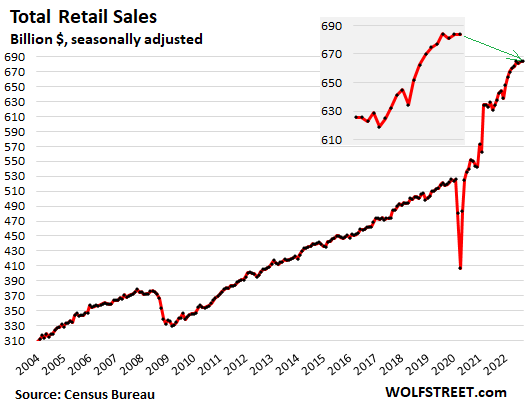
Sales at New and Used Vehicle and Parts Dealers, the largest category, edged down by 0.4% in September from August, to $128 billion, seasonally adjusted, but was up by 5.6% from a year ago, and by 23% from September 2019.
The sales increases since 2019 come from much higher prices of new and used vehicles, on much lower volume as the industry has had huge supply problems.
Used vehicle prices have dropped from their crazy spike, and there is now plenty of supply on dealer lots as price resistance has finally set in. The number of used vehicles sold is down about 15% from 2019.
New vehicle prices continued to surge in September. Inventories of full-size trucks, which were depleted last year and earlier this year, are rising, and some dealers are overstocked, and are slapping on big discounts. Smaller vehicles with good fuel economy have sold out, and there are long waiting lists, including for EVs. So new vehicle unit sales – down 19% in Q3 from Q3 2019 – are not yet constrained by demand but by supply.
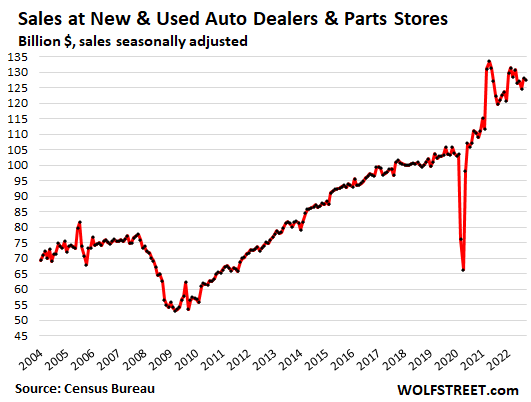
Sales at ecommerce and other “nonstore retailers” rose 0.5% to a new record of $109 billion, seasonally adjusted, up by 11.6% year-over-year and up by 71% from September 2019, as the shift in sales from brick-and-mortar stores to online sites continued relentlessly.
Included here are sales by the ecommerce operations of brick-and-mortar retailers, and by stalls and markets:
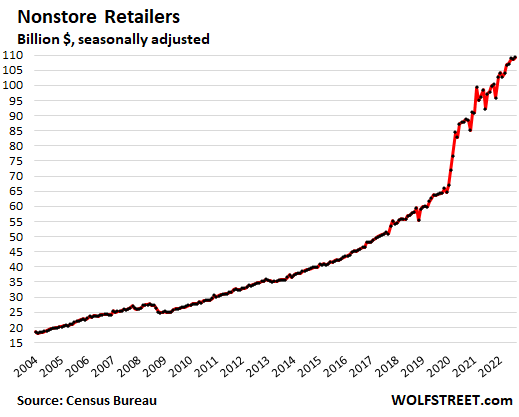
Food and Beverage Stores: Sales, at $79 billion, were up 0.4% for the month, when the CPI for “food at home” – which largely reflects food bought at grocery stores – rose by 0.7%. Year-over-year, sales rose by 6.4%, about half the rate of CPI for “food at home” (13%). Compared to September 2019, sales jumped by 24%:
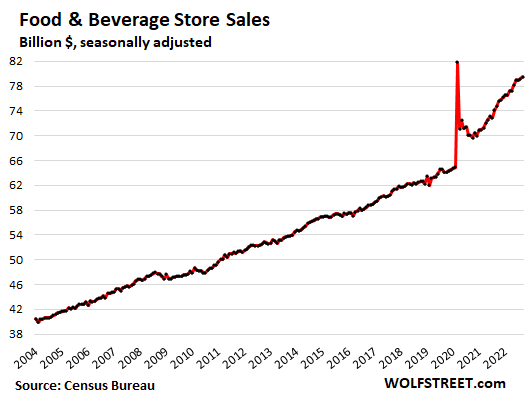
Food services and drinking places: Sales rose by 0.5% in September from August, and by 11.4% year-over-year, to a record $87 billion. This increase largely reflects inflation: The CPI for “food away from home” – restaurants, vending machines, cafeterias, sandwich shops, etc. – jumped by 0.9% in September from August, and by 8.5% year-over-year, the worst since September 1981.
Compared to September 2019, sales were up 33%.
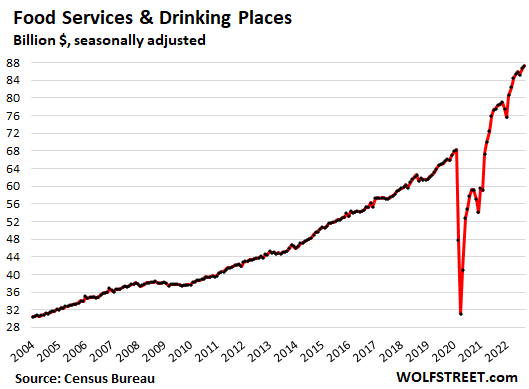
General merchandise stores: Sales rose 0.6% for the month, and 4.1% year-over-year, to $59 billion, up by 21% from September 2019. Walmart and Target are in this category, but not department stores:
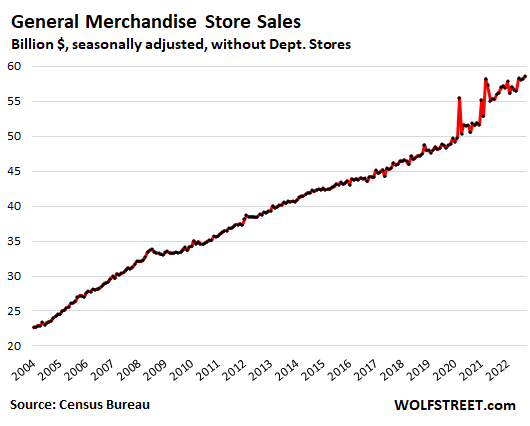
Gas stations: Sales fell 1.4% for the month, the third monthly drop in a row, to $63 billion, the lowest since February, as the CPI for gasoline has plunged for the third month in a row, and is down by 24% from the peak in June. Sales were still up by 21% from a year ago, and by 48% from September 2019.
Sales at gas stations include all the other goods they’re selling, such as food, beverages, motor oil, and other stuff. The price drop in gasoline may have been moderated by price increases in this other stuff.
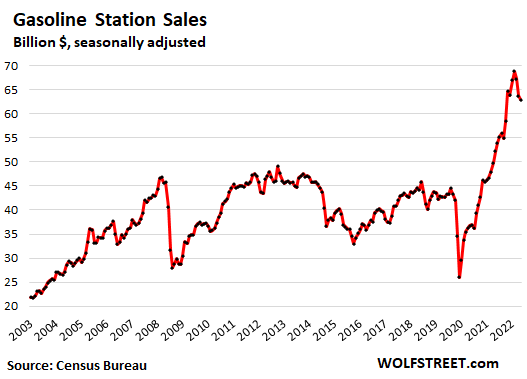
Building materials, garden supply and equipment stores: Sales dipped 0.4% for the month to $43 billion, but were up 9.7% year-over-year, and 38% from September 2019:
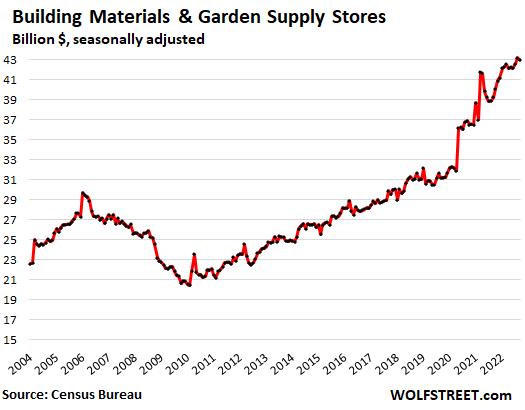
Clothing and accessory stores: Sales rose 0.5% for the month and 6.4% year-over-year, to $26 billion, up 18% from September 2019:
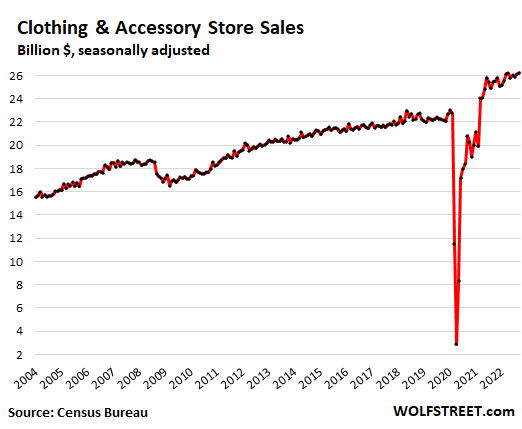
Miscellaneous store retailers (includes cannabis stores): Sales fell by 2.5% for the month, to $15.6 billion, but were up 8.2% year-over-year, and 41% from September 2019:
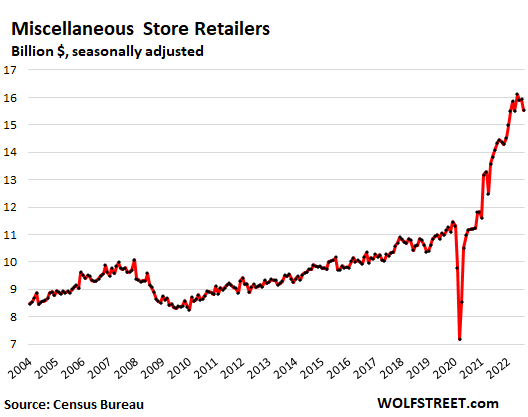
Furniture and home furnishing stores: Sales fell 0.7% for the month to $12 billion, and were up less than 1% year-over-year. Compared to September 2019, sales were up 17%:
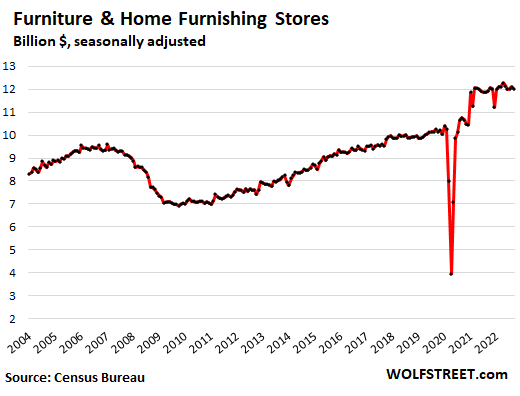
Department stores: Sales rose by 1.3% for the month, to $11.6 billion, and were up 1.8% year-over-year, and 4.8% from September 2019, as big price increases pushed up sales.
Since 2000, sales were down 42%. Department store sales have moved from mall stores to the internet, including at the ecommerce sites of the few surviving department store chains:
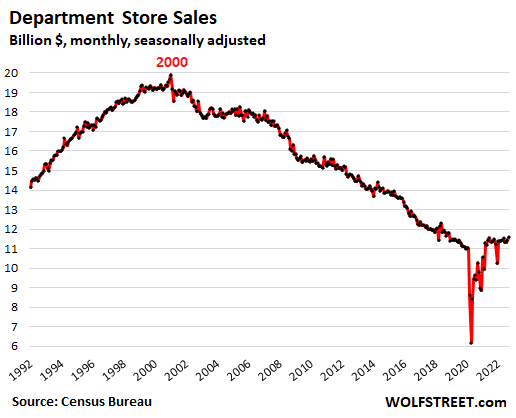
Countless department stores and department store chains, from Sears on down, filed for bankruptcy and were mostly liquidated. Department stores were once upon a time the iconic place where Americans shopped. Today, only a small number of chains survive, such as Macy’s, and even they have been closing lots of stores every year for many years, and lots of malls, those that haven’t been shuttered yet, have boarded-up department stores as anchors.
Americans have found out that anything you can buy at a brick-and-mortar department store, can be bought online, including at that chain’s website.
Back in the early 1990s, department stores sales accounted for around 10% of total retail sales. By February 2020, just before the pandemic, they accounted for 2.4%. In September 2022, they accounted for only 1.9%. On track to irrelevancy:
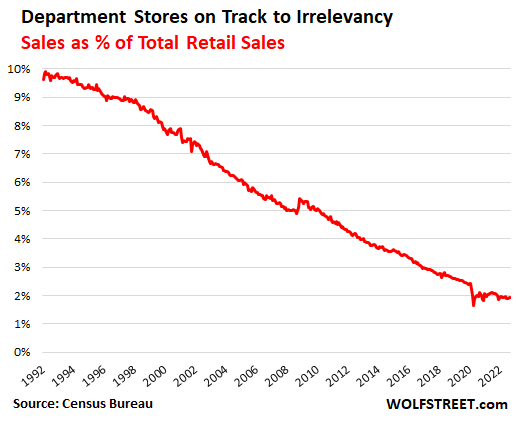
Sporting goods, hobby, book and music stores: Sales fell 0.7% for the month, to $9.2 billion, but were up 3.7% year-over-year. The CPI for sporting goods rose for the month but was down 1.1% year-over-year. Compared to September 2019, sales were up 38%:
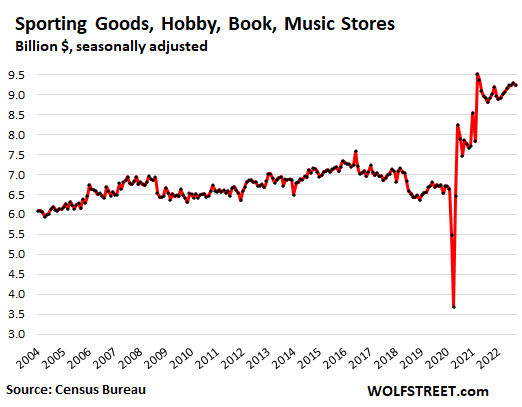
Electronics and appliance stores: Sales fell 0.8% for the month, and by 8.6% year-over-year, to $7.4 billion, and where down even from September 2019. Retailers in this category are dealing with price drops that are particularly steep for consumer electronics. In September:
- CPI consumer electronics: -0.6% month-to-month; -10% year-over-year.
- CPI appliances: -0.3% month-to-month, +1.7% year-over-year
In this category are only specialty electronics and appliance stores, such as Best Buy’s brick-and-mortar stores or Apple’s brick-and-mortar stores. It does not cover the electronics and appliance sales at other retailers, such as Walmart, and it does not cover ecommerce sales of electronics and appliances:
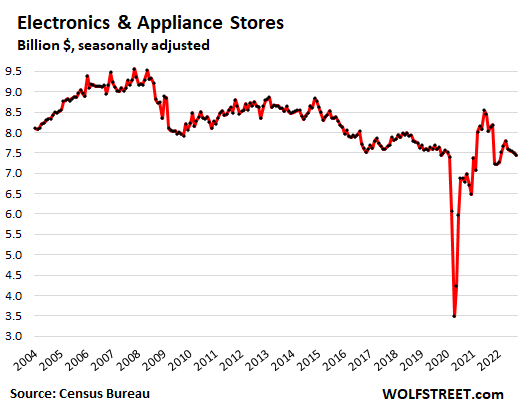
Enjoy reading WOLF STREET and want to support it? You can donate. I appreciate it immensely. Click on the mug to find out how:
![]()


I can read this two ways.
“But gasoline prices plunged, and so sales at gas stations fell.
Wait a minute… Sales here are in dollars. So the same amount of fuel sold at lower prices produces lower revenues — which is what is reported here.
But the quantity of gasoline sold, in millions of barrels, is tracked by the EIA — but NOT in terms of what gas stations sell to consumers, but in terms of what refineries, blenders etc. sell to gas stations. So this is a completely different data set.
In terms of millions of barrels of gasoline sold to gas stations, we can see the effect of “demand destruction” from high gas prices:
https://wolfstreet.com/2022/09/14/gasoline-demand-destruction-accelerates-despite-plunge-in-gasoline-prices-consumption-drops-to-august-1997-level/
We should get another truck shipments update to estimate the unit figures for goods rather than the inflated dollar figures.
Might be informative to include on these charts a line with numbers adjusted for inflation to see the relative demand easier? Just a thot…
Lesser folks are trusting dollar figures now. This should be a big warning ⚠️ sign for our politicians.
Bingo! Wolf, you nailed it. The fact is that “sales” should be reported in terms of Sales Dollars, and Sales Units. Products with high inflation rates can show great “sales” figures but be losers on unit sales. Net margins added to the data would also be an interesting feature.
Thanks for pointing that out.
By the way, not too concerned about gas sales to consumers as gasoline sold to gas stations doesn’t sit in inventory more than a day or so before needing to be resupplied. So, the sales to gas stations volume is pretty close I’d say.
Nice (as in very good to see) chart.
Also good to see clothing and furniture stores relatively flat.
If people don’t “need” so many durable goods, it’s hard to play “planned obsolescence”.
Appliances are getting really really bad, in that way, as are cars.
Thank you for an excellent article. It shows that much of our economy is getting gutted. Despite the oncoming labor shortages, many jobs will disappear, and I predict that most of the bottom half of new jobs created will pay less, particularly as automation and AI developments render many low-skill employees redundant.
According to credit karma, in California, “as of 2020, the state’s median household income is $78,672.” That is not a lot given house prices and rents charged now in California. Furthermore, “[o]ver the last 10 years, California’s median household income has risen by roughly 29.2%.”
That means that if inflation was running at more than 2.9% per year, on average, Californians at or below the mean income would have seen loss of income in real dollar terms. Like other Americans, about half of Californians have been getting less income in real dollar terms for ten years. The same appears true for most Americans.
Of course, there are wealthier Californians, and Americans, and all of those who can pass through inflation, e.g., by raising prices on their businesses or charging more for their work per hour, who have not suffered any loss of income in real dollar terms. Nevertheless, for the majority of Americans (who apparently often earn less than the median in California), the increasing financial pressure on their disposable income from the continuing, high inflation, is going to limit their purchases more and more to necessities, gifts to immediate family, and carefully budgeted vacations or goods with great utility to their families.
Coupled with the baby boomer’s retirement, unless the Millennial generation can make up the shortfall by inheriting a lot of money, which I doubt, most consumption will go down more and more. It makes you wonder if the banksters or Sith Lords, e.g., at Blackrock, might lose power in the coming years when Americans become poor and desperate enough.
Here It Comes (perma-profit guru) assured us just yesterday that buttom is in and broad recovery has begun.
What happened? Why is market down? Why is Tesla down 7% today?
Edit: Tesla is down $100 (around 30%) since Kunal called me a fool for shorting it few weeks ago. Sold half of Tesla puts today (in case it bounces of $200). Aprox 300% ptofit. Hehehe
Happy weekend, everyone.
Don’t expect for Kunal to show up today :-]
But then how knows? Weirder things have happened.
Wolf,
I am watching Eli Lilly (LLY). That one defies gravity and interest rates, just keeps climbing. Price/sales is 10, price/book is 36.
Bought couple of puts in it to keep it on my radar. Will jump on it when it stumbles.
bogles my mind how lilly has more market cap than pfizer and merck!
Look at Danaher, DHR! typical conglomerate. But, one with more market cap than UPS, INTEL, Verizon, etc.
I will check it out, Michael. Thanks
made some money shorting danaher! Lilly is six largest increase in market cap when compared to pre pandemic high, as of close on friday.
Lilly:
Pre pandemic 2019 52 wk high market cap : 146 billion , current market cap 314 billion, marketcap increase 169 billion ( 117 pct). Don’t know what justifies it! This puts lilly at sixth position in terms of increase in market cap compared to any other company traded on american exchanges. Only five other being, Apple tesla, msft, goog, unh.
DHR:
pre pandemic 2019 52 wk high market cap: 117 billion, current market cap 184 billion, market cap increase 66 billion ( 56 pct) this put danaher at 10 largest market cap increase in entire american stocks universe!
pfizer pe 8, merck pe 13, jnj pe 23, lilly pe 52!
If I could short Kunal’s financial life, I’d never have to work again.
It’s a colossal mistake to assume that anyone is actually trading exactly the way they talk on a blog.
And don’t assume anyone who posts comments is a real person. Kunai may be a bot.
If it walks a like a bot, if it quacks like a bot, then it must be a bot, or a troll!
I think the symbol you’re looking for is SKNL.
He’s a good kid, and my blog buddy.
It’s a troll… don’t give it legitimacy!
You are a brave man to short Tesla, so many people did this prematurely and lost their lunch. I remember wanting to short it years ago at 80$ a share. Thank heaven I held off on that. Although I’ve rarely seen a more obvious stock to short…
Thank you Happy,
I think it was you who told me I was early with Msft and Apple. And I was, by two weeks. Two weeks is a lot with options. Glad it worked out.
E-Commerce results can be such a scam. My local CVS has items in the store marked up approx. 6% over what is listed on it’s website. I can order for store pickup in an hour using the website prices. So they are training me to have their limited staff pick my order off the shelf, so I can get a 6% discount and they can brag during their quarterly report about their e-commerce sales. I’ve seen similar results at the pet stores (Petco & Petsmart)…
Thanks for that info. I was in a CVS store, having complete sticker shock, and swore that (aside from the meds I was getting) I would never spend a penny there. I’m shocked anyone would throw away bucks like that.
smashsc,
Not a “scam.” It doesn’t matter how the product gets to your house, whether it’s by UPS or whether you take it home on a bicycle from a pickup location. For example, Amazon has pickup lockers where you can pick up your merchandise with a code that Amazon gives you. It’s still an online sale, even if you pick it up at a locker or at a store or wherever. What matters is where the sale was originated and paid for. If you ordered online and paid online, it’s an online sale, and it doesn’t matter who carries the product to your house.
There was a good deal on 256gb micro sd cards at bestbuy. My local store had only 2 left in stock, I was not able to go there for atleast next 3 days, so I bought it online for store pickup. I went to the brick and morter store to pick it up. Was that an ecom sale or store sale? Why does it matter, they made a sale. Or is classified as an ecom sale to justify the grossly bloated IT department where all kinds of funny business happens?
If you buy online and pay online, it’s ecommerce, no matter how the thing gets into your house, whether FedEx delivers, or you pick it up at your son’s house, or at a store, or at an Amazon locker.
If you look online and then do the transaction at the store, and pay at the store, it’s brick & mortar.
Whether UPS delivers to you, or whether you pick it up is just a question of the “last mile,” not of the transaction.
A few years ago, my wife bought a laptop at BestBuy online. They offered two choices: pick up at the store, or deliver to the house, same price. But the store would have to wait for it to be delivered to the store, and it would be available for pickup a day after the store got it; whereas delivery to the house was direct, and a day faster — and same price, and she didn’t have to waste her time driving to the store and dealing with the humans there. Some of these decisions are no-brainers.
In terms of your theories as to why, you’re making up fanciful nonsense.
“Sales at New and Used Vehicle and Parts Dealers, the largest category, edged down by 0.4% in September from August, to $128 billion, seasonally adjusted, but was up by 5.6% from a year ago, and by 23% from September 2019.
The sales increases since 2019 come from much higher prices of new and used vehicles, on much lower volume as the industry has had huge supply problems.”
Subprime car loans from the likes of Santander, etc. have enabled these price increases. People aren’t “paying the prices,” they’re “borrowing the prices.” We are in a raging mania credit bubble, right near the peak. Until the credit spigot is shut off, look for inflation to continue raging on.
This raging mania and price hyperinflation has also been seen in the RV industry. We went from a situation in 2020 where the industry was trying to cut bait on all of their inventory quickly, reducing prices massively, to price increases of more than 50% on new stock with nothing on the floor to sell. That has started to mitigate somewhat, especially in the cheaper travel trailers and such, but truck campers from Northern Lite and Arctic Fox are still sold before they hit the lots, and the aforementioned brand is pushing $80,000 for a new unit. Yes, an $80,000 truck camper.
We are in the most raging mania imaginable, and it is unrelenting. Jerome Powell is the most miserable failure of a central bank head since perhaps the guy in Weimar Germany. He stood up there and boldly proclaimed that “inflation is transitory,” and that he was “not even thinking about thinking about raising rates” as inflation was already raging out of control. Had he acted 18 months ago by sharply increasing rates at that time, while completely cutting off QE and implementing QT, we’d still be in for some pain, but nothing like what’s coming.
Inflation has not “peaked” whatsoever. In fact, I wouldn’t be surprised to see a 10%+ CPI reading in the next few months. Everything I see in day to day life suggests entrenched inflation which is now starting to rage out of control. There is simply way too much money chasing too few goods and services. FIRE JEROME POWELL.
Very worrying. If folks are indeed floating on credit to “heroically” maintain a standard of living, they are weakening their balance sheets, and setting up for serious pratfalls. Lo and behold, in such event, I expect they will cry for “justice,” meaning more freebies, more printing. This is a perilous sort of childishness.
Just to distinguish: Subprime-rated customers mostly buy used vehicles. In terms of new vehicles, low interest rates helped finance those crazy prices.
Wolf I would hate to get grouped into that category of people. We buy used cars because they fit our budget easily and I was a former mechanic, so I can save a few bucks by turning my own wrenches.
Working in or around the improverished neighborhoods of Queens, they seem to defy the logic of your statement lol. Everyone is rocking new vehicles, ones that are several if not 10s of thousands more expensive than our 2011/12 vehicles.
What I said was the subprime customers are mostly buying used vehicles (because that’s all they can afford to finance).
I didn’t say that most used vehicles are bought by subprime customers. Lots of people buy used vehicles for lots of reasons, and they have top-notch credit.
In a good year, there are about 23 million used vehicles sold retail and about 14 million new vehicles retail.
Queens is where a few day ago a gang broke into a used car office at night, took the keys to 20 luxury cars, and drove off. In the past the gang would lay hot luxury cars off overseas. These days they’ll probably keep them to commit crimes, then ditch. Smash’n’Grab is new retail in New York. IPO coming.
Wolf, would increasing banks reserve requirement bring down inflation? Pretty sure it sits at zero now.
This is your second comment to this effect in two days, and the second time I replied. So I’m just going to repeat what I replied to you yesterday:
It wouldn’t drain anything because banks have $3.1 trillion in reserves at the Fed, which is about 20% of total deposits, and about double a 10% requirement.
I think there will be a flood of used RVs hitting the market in the next few years.
I think hurricane Ian did a good bit to take the excess inventory of RVs off the potential market. Plus, there’s a bunch of people with nowhere to live post Ian who have a high potential of looking to an RV for habitation.
I think everyone with an RV left town prior to Ian hitting.
AGREE Bill:
Went east to Arcadia and back yesterday for family reasons; what a mess, but many workers on RT 70 clearing massive amount of trees down, and in spite of some one way areas to allow workers more room, the roadway was clear…
Saw many homes with severe damage, roofs off, etc., and RVs parked in yards.
We, in this case the family WE, thought we were going to be able to get a RV ”travel trailer” in the next year or so, but looks like it will take several years for rebuilding of homes, so unlikely anytime soon.
The area we were in was somewhat peripheral to the main route of the storm, not to mention the places directly hit with the huge surge near the gulf.
RVs definitely going to be HOT for a while IMHO.
It’s going to be the same with boating. Unless you love to boat, you realize the first big ticket repair bill what the “acronym for bust out another thousand” means. Except soon it will be ten thousand.
There are millions of RV’s sitting around this country not being used. It kind of became a right of passage thing with retiring boomers to buy a RV when they retired with some fantasy of traveling and seeing the Country and living free and easy. They soon found out traveling by RV is both expensive and a lot of work. Fuel is expensive, parks and campgrounds are crowded and usually require reservations well in advance. Driving an RV can be a pain in the ass, especially in heavy traffic and parking is often an issue.
After a few trips, most RV’s sit and depreciate while their owners make payments. Unless garaged or covered, they deteriorate quickly and owners are usually upside down on payments vs. resale value. As money gets tighter, the RV market is going to see some serious revaluations….
Yes, you go ahead and cover your RV and deal with the mold! Or store it with the blinds down. Same outcome.
Ya, I don’t understand rvs. Seems like a used car with decent fuel efficiency and cheap hotels/Airbnb’s better value and cheaper. Or tents. But haven’t done a major deep dive into the numbers. But it seems like one of those ideas that looks cool and then reality.
Last thing I want to do is change septic during my retirement.
In m home town, trailers are starting to pop up for sale like Daises…
Sign of the drop starting to form?
Regarding truck campers, we are already pricing for some brands for sure. Four wheel camper brand was unobtainable during the pandemic, new sales backed up more than a year (factory in CA), used on Craigslist selling in hours with multiple offers, now the used market is still hot (they are a great product), but prices are 10% lower and listing for days when not priced well, they just moved into a much larger factory so new campers will be flowing next year or two. I think in 2 or 3 years there will be a fire sale in the used market.
past peak pricing I meant to say…
If by “the guy in Weimar Germany” you mean Hjalmar Horace Greeley Schacht, I beg to differ. Boundless ambition and unscrupulousness and overarching ego, sure. But he was a financial genius who saved the Weimar republic with the Rentenmark, kept the recovering country fiscally functional while amassing vital raw materials and paying for rearmament by leveraging creditors, shuffling funds, and compelling the mobilization of Germany’s commercial wealth for government use. Making your trade partners front you the goods necessary to make war on them is a cool hand to play. A founder of the Democratic party in Germany in 1919, he became a national socialist because that’s where the money and power was. His competence was acknowledged by his fellow central bankers in the eventual Allied countries.
Quite agree otherwise.
Wolf – Saw an article in Reuter with the following.
‘US Treasury asks major banks if it should buy back U.S. government bonds’
Any thing of significance here? Will this reduce the treasury yields?
The Treasury had a meeting with primary dealers to explore this. They had these discussions at least twice before that I know of, in 2015 and last summer. They would offer to buy back less-traded bonds that they’d issued years ago and replace them with new bonds that are more easily traded. But this is very complicated because any buyback at market price now would be below face value. If they buy them back at face value, it would instantly mean that yields would have to plunge to meet those levels. They ended up not doing anything the last two times they discussed this, and there is a good chance that this will go nowhere.
If you think that you will find better information about our financial system on some other source, you are mistaken.
Pure wisdom dispensed daily.
Wolf’s rare prediction of a overdue rally was very profitable for those of us who are only in it for the money.
What is the purpose of this then?
Just to see if banks want an illiquidity bail out?
Like I said, if they can improve liquidity by replacing old bonds with new bonds, well, maybe it’s worth a try.
High gas prices are driving up my ecommerce purchases. I’ve never bought more online than the past few months because a round trip to the nearest store is 30 miles.
Comest thou hither to me…or something.
This is best financial site. Period. I have been reading for years. I have never made a comment but when I saw Concerned guy’s post I had to. I saw same article and immediately thought of wolf. This “ liquidity issue “ is simply cry babies who don’t want to take a haircut because of their bad decisions. It’s clearly a broader problem of morals and ethics no longer in any equation here in US. It’s so sad.
Catdaddy boldly proclaimed “This is best financial site. Period.”
I agree 100% !
Wolf’s explanations are well written, clear and understandable. AND, most importantly he backs up what he writes with actual DATA. Not opinions.
You don’t have to agree with his conclusions … but if you comment on them you had better have something more to offer than just your “informed opinion”.
One of my “go to” sites every day.
I like the site but some responses don’t mean anything to me. Dont have the financial background. I’m curious what professions the posters here have as background. 50% or more financial ?
Mine is software, some basic mutual fund investing so, yes, about 20% of the posts are mostly unintelligible to me.
I’m not complaining that’s my problem of course.
I could spout about the virtues of polymorphism and encapsulation but noone here would (rightfully) care. And besides that’d give away how long ago I was a software person !
If there was a relatively easy way for Wolf to determine each posters profession (current or past) the distribution might be slightly interesting.
Agreed. I’ve learned more reading Wolf’s technical presentations and podcasts (and the well thought out comments) than a good majority of the financial seminars I’ve attended in the past two years (which haven’t been bad, just not as clear and clearly considered as what comes up here)
Wolf’s parabolic graphs are very similar to the SPX and Nasdaq. Those charts are a good representation of the future result cone potential.
Revert to the mean or lower?
If interest rate history says unless the Fed raises rates above the CPI #. The inflation # will not subside.
Hella spooky!
The Trillion $ question of why everything has gone parabolic?
Pass out $500 bills at your family Monopoly board game when your neighbor or rival rolls the dice! Give every player $500 bills regardless of if they pass “Go”.
If you land on Boardwalk with a Hotel. No problem. Here is the $2000 rent. We will cover you. No need to repay. Forbearance.
The banker is not following the rules.
Why play a game with an idiot or idiots in charge?
Wolfstreet beats Wallstreet.
Waiting for Apple to start cutting prices. I mean how many years can you sell iPhone 5 as the new model, and for higher price.
Promised girlfriend the MacBook Air Max Pro New Edition. Extra memory is extra $$$.
Subway Mikes Giant Sub now cost $19 it’s been about 6 months since I purchased one before today. About a $4 increase in price. Sure you still can feed 4 people off the sandwich #8 Club. it’s just wild too see prices sky rocket on your every now and again favorites. 3 degrees down bubble on S&P 500 as next round of rate hikes will undoubtedly drop this oversold market another 3-500 points. It’s nice to know the bottom and worst is yet too come. All the lies from analyst about what is price in. Ha Ha Ha
With all the crazy amount of sales it’ll be interesting to see what happens with earnings season coming up here. I get margins are compressed but God damn Americans know how to spend money!
How does everyone have 32% more money to spend on all this stuff?
Nobody’s given me a 32% raise at work.
Maybe you should try to change jobs? I’ve read a report that said that the quitters (job hoppers) got the big raises, and the stayers got much smaller raises, if any. That’s how that works.
Funny how true this is. Same idea with new customer acquisition costs versus retaining old customer. Sad truth is now all this corporate greed has taught younger workers to have no loyalty and squeeze employers…. And with the tight labor market they finally can! Companies getting what they deserve😂
Well just like everything in life, there’s risks there too. Say you quit Google to join Peloton, Coinbase etc, 6 or 7 months ago, then you may have possibly committed the biggest blunder in your life. A number of posters in Blind mentioned that they know people who did what I’ve just described, and guess what, a bunch of people on H1Bs have been forced to leave the States.
Now some people will focus only on the H1B aspect, but say you are not on H1B, and you got fired by your new company, it’s very likely Google will not hire you back and you’ll have to join a different new company at LOWER pay.
I don’t have an advice here. It’s hard to tell what’s going to happen in the next few months, the next year, etc. But no matter what, stretching your dollars is a must have strategy in your arsenal.
Always been that way in the construction industry that I worked in for 50 years or so Wolf.
Longest full time actual job, as opposed to being contractor or consultant was 3 years, and every time I jumped my net pay increased or at least kept up with the official BLS inflation rate, (a resource I used constantly in the work I did.)
I can’t help but wonder how my 90 year old mother’s carer is doing in this inflationary period. My mom is on a fixed income so her carer hasn’t asked for a higher salary. So she is facing all this inflation – and most of it in places she can’t cut back – on the same salary as before. It makes me wonder how many people are in a similar financial boat. (And before you think I am a complete jerk – of course, my husband and I are going to help. But what of those who have no one to help?)
Still no recession in consumer spending or jobs. I’d say the fed is gonna keep raising rates with confidence. The constant “pause” cry babies will have to sit in the corner.
My investments are 50% income, 50 cash. Not gonna fight the fed. Keeping that powder dry for lower prices in the next year or 2.
Marx and Keynes were right about rentier capitalism.
I think the charts pretty much reflect what you would expect to see, as the economy begins to roll over. Up until now, construction related employment has stayed fairly strong despite housing sales and rising mortgage rates.
I expect to see that change come spring when many construction workers in northern states, who normally don’t work during winter, find far fewer contractors starting new developments.
Once construction employment begins to lag, the economy will turn south very quickly.
I went to my barber yesterday. On the window was an out of business sign.
:-(
Maybe it’s time for a “Flobee”.